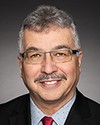Thank you to you all for coming to present to us today. This is an area that I think concerns all of us throughout Canada, the area of health care. I'm from the Northwest Territories, and we certainly have our share of issues across the north. We are a large area with 33 communities, struggling to have the services provided in our communities. It's very rare that you'll see a doctor twice in the communities. Even the nurses are locums, for the most part, who come in for a short stint and then leave.
About 70% of the Government of the Northwest Territories budget is spent in the area of the social envelope. A lot of it is being spent on health. When it comes to our aboriginal population, we have first nations people who are covered through non-insured health benefits, and we have the Métis people who are covered through a program funded by the Government of the Northwest Territories. So they are carrying a huge burden of costs. It's really causing a lot of challenges for them to provide health care for aboriginal peoples.
I'm very curious to know how the non-insured health benefits are calculated. In the Northwest Territories a set amount of money is provided on an annual basis. I'm not sure if it has increased over time, but I know the government is spending roughly three times what is provided, because the federal government hasn't, up till now, been willing to cover the actual costs. There seems to be a formula that is used and it is not really measuring the health needs of the first nations people.
My first question is on that area, then, the real needs of aboriginal peoples in the Northwest Territories. We don't have treatment centres either, so addictions is an issue. Health is an issue. Off-loading to the territorial government is an issue.
Maybe you could just talk about that a little bit, and then I'll ask my next question.

